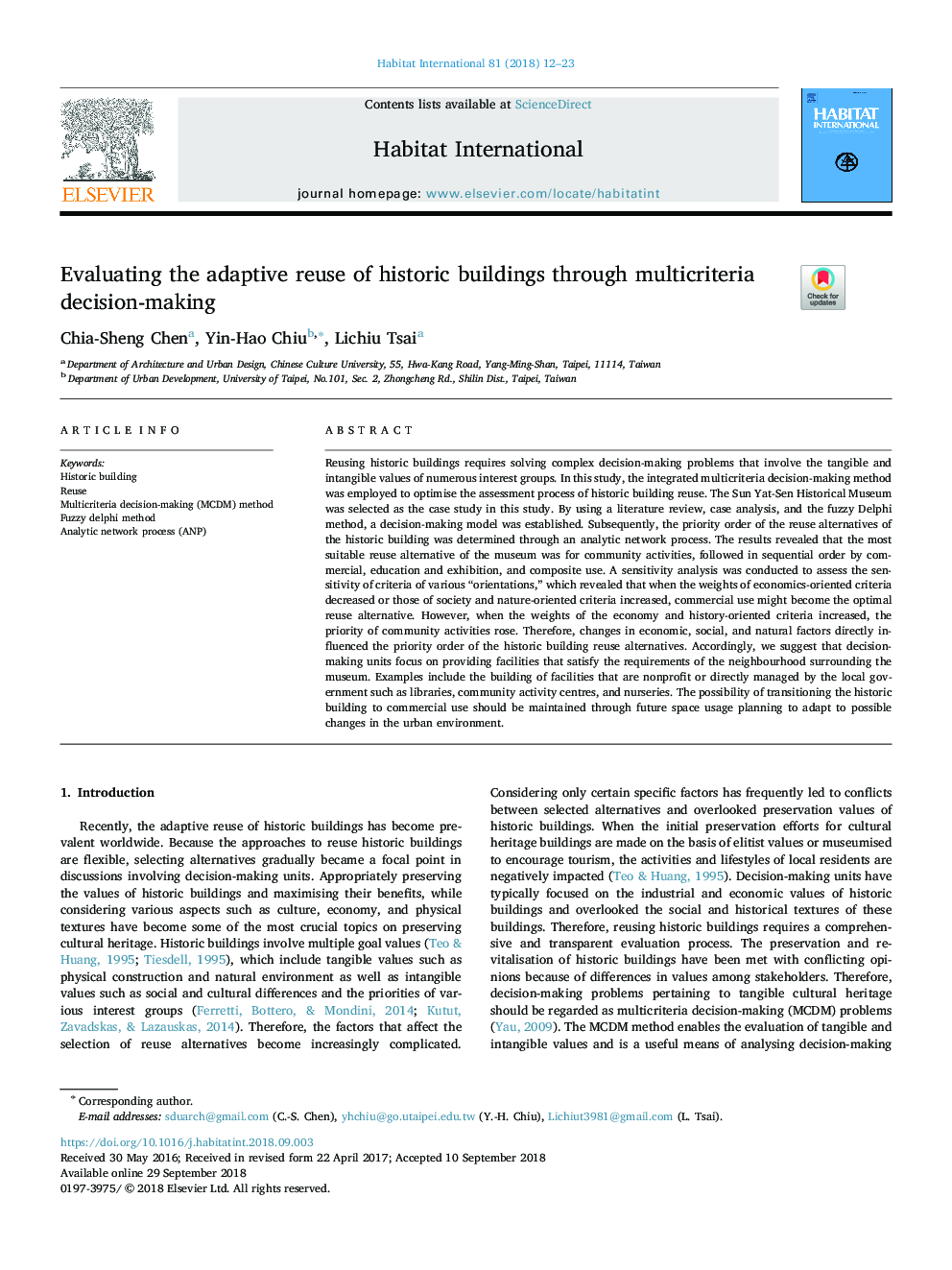| کد مقاله | کد نشریه | سال انتشار | مقاله انگلیسی | نسخه تمام متن |
|---|---|---|---|---|
| 11011905 | 1802848 | 2018 | 12 صفحه PDF | دانلود رایگان |
عنوان انگلیسی مقاله ISI
Evaluating the adaptive reuse of historic buildings through multicriteria decision-making
ترجمه فارسی عنوان
ارزیابی استفاده مجدد سازگار از ساختمان های تاریخی از طریق تصمیم گیری چند معیاره
دانلود مقاله + سفارش ترجمه
دانلود مقاله ISI انگلیسی
رایگان برای ایرانیان
کلمات کلیدی
ترجمه چکیده
استفاده مجدد از ساختمان های تاریخی نیازمند حل مسائل پیچیده تصمیم گیری است که ارزش های ملموس و غیرمترقبه گروه های مختلف را شامل می شود. در این مطالعه، روش تصمیم گیری چند منظوره یکپارچه برای بهینه سازی فرایند ارزیابی استفاده مجدد از ساختمان های تاریخی مورد استفاده قرار گرفت. موزه تاریخی سنت یات سن به عنوان نمونه موردی در این مطالعه انتخاب شد. با استفاده از بررسی ادبی، تحلیل مورد و روش دلفی فازی، یک مدل تصمیم گیری ایجاد شد. پس از آن، ترتیب اولویت جایگزین های مجدد استفاده از ساختمان تاریخی از طریق یک فرآیند شبکه تحلیلی تعیین شد. نتایج نشان می دهد که جایگزین موثر ترین استفاده مجدد از موزه برای فعالیت های جامعه است، به دنبال ترتیب تجاری، آموزش و نمایش و استفاده از کامپوزیت است. برای ارزیابی حساسیت معیارهای مختلف جهت گیری، یک تحلیل حساسیت انجام شد. که نشان داد زمانی که وزن معیارهای اقتصاد محور و یا معیارهای جامعه و معیارهای طبیعت افزایش یابد، استفاده تجاری ممکن است جایگزین مجدد استفاده مجدد شود. با این حال، هنگامی که وزن اقتصادی و معیارهای تاریخ گرایی افزایش یافت، اولویت فعالیت های جامعه افزایش یافت. بنابراین تغییرات در عوامل اقتصادی، اجتماعی و طبیعی به طور مستقیم بر جایگزینی مجدد استفاده از ساختمان تاریخی تأثیر می گذارد. بر این اساس، ما پیشنهاد می دهیم که واحدهای تصمیم گیری برای تأمین امکانات مورد نیاز محله های اطراف موزه مورد توجه قرار می گیرند. نمونه هایی از جمله ایجاد امکانات غیر انتفاعی یا به طور مستقیم توسط دولت محلی مانند کتابخانه ها، مراکز فعالیت های اجتماعی و مهد کودک ها می باشد. امکان انتقال ساختمان تاریخی به استفاده تجاری باید از طریق برنامه ریزی استفاده از فضای آینده برای انطباق با تغییرات احتمالی در محیط شهری حفظ شود.
موضوعات مرتبط
علوم انسانی و اجتماعی
علوم اجتماعی
توسعه
چکیده انگلیسی
Reusing historic buildings requires solving complex decision-making problems that involve the tangible and intangible values of numerous interest groups. In this study, the integrated multicriteria decision-making method was employed to optimise the assessment process of historic building reuse. The Sun Yat-Sen Historical Museum was selected as the case study in this study. By using a literature review, case analysis, and the fuzzy Delphi method, a decision-making model was established. Subsequently, the priority order of the reuse alternatives of the historic building was determined through an analytic network process. The results revealed that the most suitable reuse alternative of the museum was for community activities, followed in sequential order by commercial, education and exhibition, and composite use. A sensitivity analysis was conducted to assess the sensitivity of criteria of various “orientations,” which revealed that when the weights of economics-oriented criteria decreased or those of society and nature-oriented criteria increased, commercial use might become the optimal reuse alternative. However, when the weights of the economy and history-oriented criteria increased, the priority of community activities rose. Therefore, changes in economic, social, and natural factors directly influenced the priority order of the historic building reuse alternatives. Accordingly, we suggest that decision-making units focus on providing facilities that satisfy the requirements of the neighbourhood surrounding the museum. Examples include the building of facilities that are nonprofit or directly managed by the local government such as libraries, community activity centres, and nurseries. The possibility of transitioning the historic building to commercial use should be maintained through future space usage planning to adapt to possible changes in the urban environment.
ناشر
Database: Elsevier - ScienceDirect (ساینس دایرکت)
Journal: Habitat International - Volume 81, November 2018, Pages 12-23
Journal: Habitat International - Volume 81, November 2018, Pages 12-23
نویسندگان
Chia-Sheng Chen, Yin-Hao Chiu, Lichiu Tsai,
